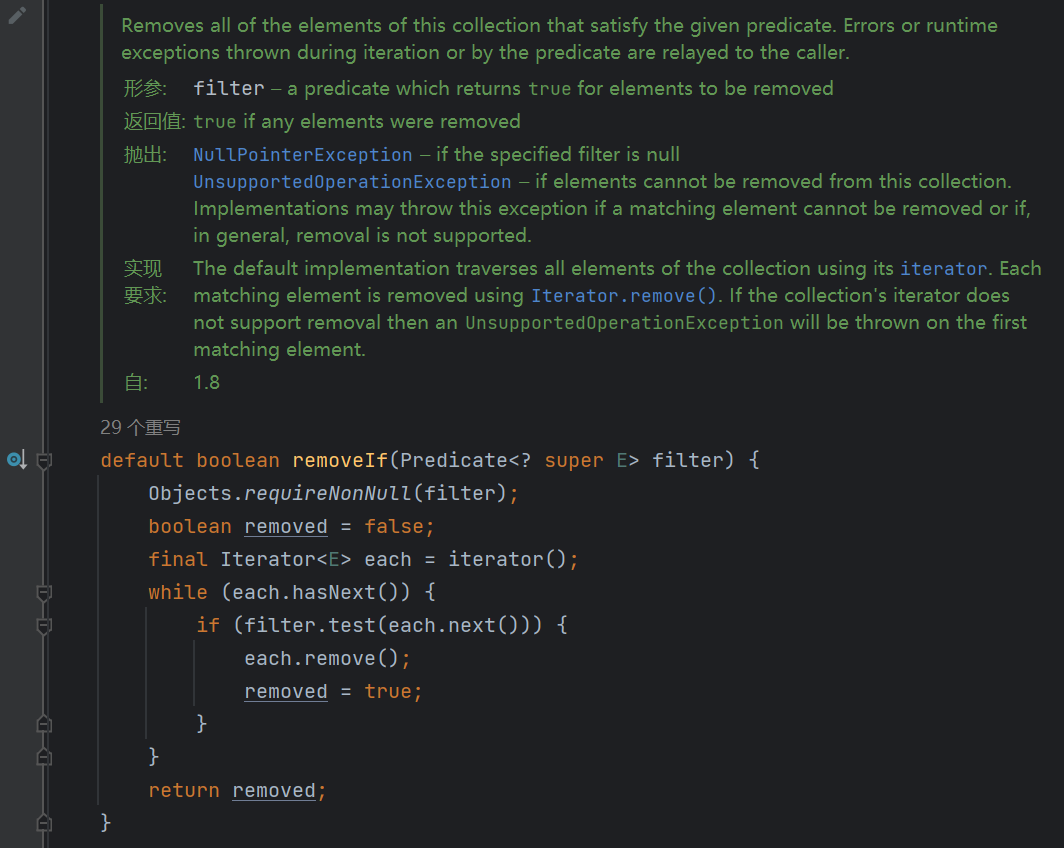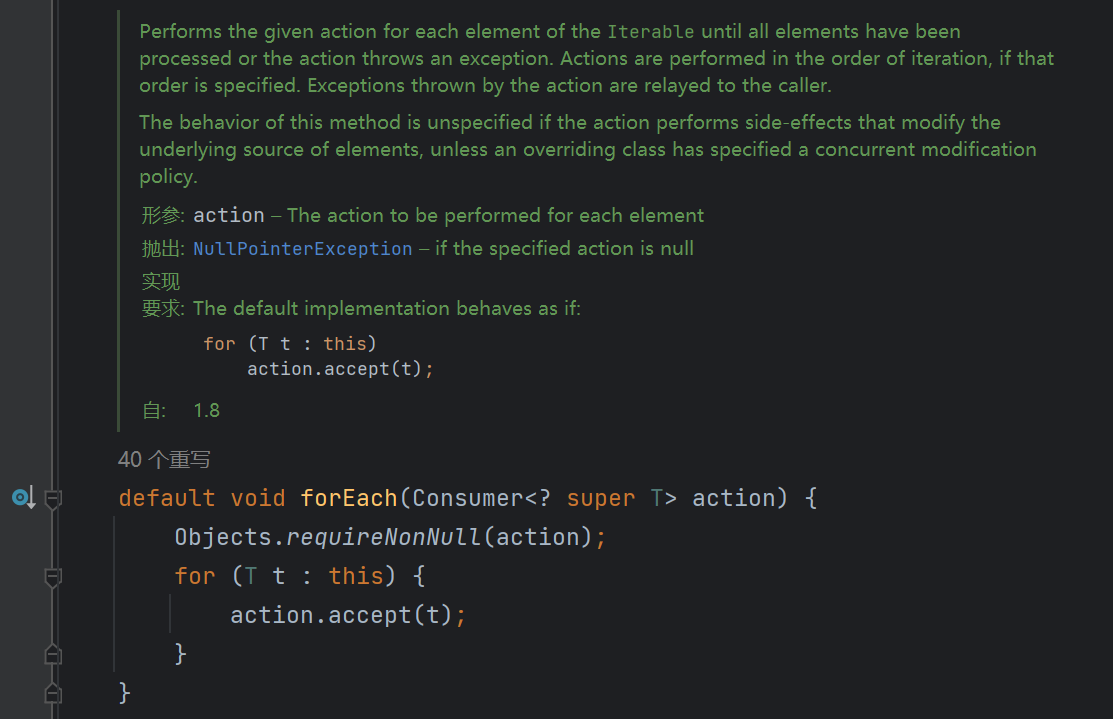Java8特性
2014年3月18日,Oracle公司发布Java SE 8,至今已经过去了8年,但是Java8发布的时候添加的一些特性,我们还是有很多人没有用上,这里对Java8添加的特性进行一些分享,让更多人能用起来:happy:,后续可能为大家分享一些Java新版本的一些特性!
Java8中添加了很多新的特性,这次主要分享Lambda表达式与函数式编程、流。
Lambda表达式与函数式编程
基本介绍
我们为View添加按键监听的时候,需要传递给View一个OnClickListener接口的实现,最传统的写法就是写一个类,对OnClickListener接口进行实现,然后将类的对象new出来,传递过去,例如test1包下的代码。
package com.lln.java8.functional.test1;
import com.lln.java8.widget.View;
public class Main {
public static void main(String[] args) {
View view = new View();
view.setOnClickListener(new MyOnClickListener());
view.click();
}
}
package com.lln.java8.functional.test1;
import com.lln.java8.widget.View;
public class MyOnClickListener implements View.OnClickListener {
@Override
public void onClick(View view) {
System.out.println("我被点了~");
}
}
当然我们还可以用匿名内部类来实现此操作,例如test2包下的代码。
package com.lln.java8.functional.test2;
import com.lln.java8.widget.View;
public class Main {
public static void main(String[] args) {
View view = new View();
view.setOnClickListener(new View.OnClickListener() {
@Override
public void onClick(View view) {
System.out.println("我被点了");
}
});
view.click();
}
}
我们会发现,每次都需要声明并且new这个类,即使使用了匿名内部类,操作还是非常冗余,其实我们实际上只会关心三个东西
- 方法的参数列表
- 方法中的核心操作代码
- 方法的返回类型
只需要这三个,我们其实就可以告诉view,你被点击后,应该有怎样的反应,也就是给一个参数、进行一些操作、给出指定结果,也就是一个函数,所以我们可以将view被点击执行的内容,抽象为一个函数,在Java中,这个抽象可以使用lambda表达式实现,我们将函数传递给OnClickListener,它在点击后会执行这个函数,可以认为这个就是函数使编程,Java中使用Lamdba表达式来实现函数式编程。
函数式编程是一种编程范式,是编程风格。
一个函数实际上应该是一定有返回值的,但是Java中存在Void,所以允许一个函数没有返回值。
我们使用lambda表达式来对上面的操作进行改造,见test3包。
package com.lln.java8.functional.test3;
import com.lln.java8.widget.View;
public class Main {
public static void main(String[] args) {
View view = new View();
View.OnClickListener onClickListener = v -> System.out.println("我被点击了");
view.setOnClickListener(onClickListener);
view.click();
View view2 = new View();
view2.setOnClickListener(v -> System.out.println("我被点击了"));
view2.click();
}
}
可以看到,创建了一个名为onClickListener的函数,并将其传递给了view,这样view被点击后,就会执行这个函数,实现对应的效果,当然,还可以创建匿名函数直接传递。
可以看到,lambda表达式表达的是一个函数,但是它需要寄托于接口,所以lambda表达式在Java中其实就是对接口的实现,但是任何接口都能用lambda表达式实现吗?那必然不行,只有接口中有且仅有一个抽象方法的时候,这个接口才可以使用lambda表达式进行实现。
Java中规定,有且只有一个抽象方法的接口,是函数式接口,该接口中,也允许有其他的默认方法和静态方法。函数式接口上可以添加注解@FunctionalInterface,例如
@FunctionalInterface
public interface OnClickListener {
void onClick(View view);
}
这个注解可以在编译时期为我们做检查,如果你的接口不是函数式接口,编译就会报错,作用和@override类似,写了就会检查,不写就不会检查,也没啥影响。
下面我们看看这个lambda表达式的具体使用方法
lambda表达式最基本的格式为
()->{}
-
() 表示参数列表
-
-> 后面跟的是函数主体
-
{} 函数主体,表达式的返回值,由这个函数主体中代码来决定
一个lambda表达式如何编写,实际上就是看它想要表达的函数式接口是如何定义的?
看test4包下的代码
package com.lln.java8.functional.test4;
@FunctionalInterface
public interface Action {
void run();
}
我们有一个名为Action的函数式接口,里面有一个无参无返回值的抽象方法
package com.lln.java8.functional.test4;
public class Main {
public static void main(String[] args) {
/*Action action1 = new Action() {
@Override
public void run() {
}
};*/
//如果是空实现,就这样写,没有任何内容,但是基本格式必须要有()->{}
Action action1 = () -> {
};
/*Action action2 = new Action() {
@Override
public void run() {
System.out.println("Hello World");
}
}*/
//如果只有一行语句,那么大括号可以省略~
Action action2 = () -> System.out.println("Hello World");
/*Action action3 = new Action() {
@Override
public void run() {
System.out.println("Hello World");
System.out.println("Hello World");
System.out.println("Hello World");
}
};*/
//但是如果有多行语句,大括号务必写上,因为需要告诉编译器,这个lambda表达式到哪结束
Action action3 = () -> {
System.out.println("Hello World");
System.out.println("Hello World");
System.out.println("Hello World");
};
}
}
看上面的代码,基本就可以理解,这里不过多描述
对于有参数,无返回值的呢?看test5包下的内容
package com.lln.java8.functional.test5;
public class Main {
public static void main(String[] args) {
/*Action1 action1 = new Action1() {
@Override
public void run(int a) {
System.out.println(a);
}
};*/
//这是完整的写法
Action1 action1 = (int a) -> {
System.out.println(a);
};
//参数类型其实可以直接去掉,因为Action1接口中
//只有一个抽象方法,jvm会自动推断他是什么类型
Action1 action2 = (a) -> {
System.out.println(a);
};
//当只有一个参数的时候,可以直接去掉小括号
Action1 action3 = a -> {
System.out.println(a);
};
//因为就只有一行语句,花括号也可以去掉
Action1 action4 = a -> System.out.println(a);
//需要注意,如果有两个参数,小括号就不能省略了~
Action2 action5 = (a, b) -> {
System.out.println(a);
System.out.println(b);
};
}
}
如果是有参数又有返回值的呢?见test6包下的内容
package com.lln.java8.functional.test6;
public class Main {
public static void main(String[] args) {
/*Action action = new Action() {
@Override
public int run(int a, int b) {
return a + b;
}
};*/
//和写普通方法其实没什么区别,直接写return即可
Action action1 = (a, b) -> {
return a + b;
};
//但是如果方法中只有一个语句,可以直接省略return
//刚刚还提到,如果只有一行语句,花括号也可以省略
Action action2 = ((a, b) -> a + b);
//多行语句则必须写return
Action action3 = (a, b) -> {
System.out.println(a);
System.out.println(b);
return a + b;
};
}
}
类型推断
如果两个方法分别接受两种不同的函数式接口,不过他们的表达方法相同,调用的时候,jvm会自动推断你写的lambda表达式表达的是什么类型,见test7包下的内容
package com.lln.java8.functional.test7;
public class Main {
public static void main(String[] args) {
//这个会被推断为Test1的实现
test1(() -> {
});
//就会被推断为Test2的实现
test2(() -> {
});
}
private static void test1(Test1 test1) {
}
private static void test2(Test2 test2) {
}
}
interface Test1 {
void test();
}
interface Test2 {
void test();
}
重载解析
我们知道,Java中支持方法重载,即相同的方法可以有不同的参数,test8包下的情况
package com.lln.java8.functional.test8;
public class Main {
public static void main(String[] args) {
test(() -> {
});
}
private static void test(Test1 test1) {
}
private static void test(Test2 test2) {
}
}
interface Test1 {
void test();
}
interface Test2 {
void test();
}
因为都是我们两个接口在lambda表达式下的表达方式相同,jvm已经不知道你想调用哪个了,最好是别这么定义,当然,我们可以进行强制类型转换,来解决这个冲突,像下面这样
test((Test1) () -> {
});
test((Test2) () -> {
});
类库函数接口
以上这些函数式接口都是我们自己定义的,实际上,Java在类库中已经为我们准备好了一套通用的函数式接口,因为是通用的,所以对每个类都进行了泛型化,便于我们提供自己类型,以满足自己的需求
在Java中,一个函数有四种情况,
- 有参有返回值
- 有参无返回值
- 无参有返回值
- 无参无返回值
所以在Java中提供的接口可以分为这四种
- 有参有返回值 Function<T, R> 函数
- 有参无返回值 Consumer
消费者 - 无参有返回值 Supplier
生产者 - 无参无返回值 Runnable 可运行
这里再介绍一个略微特殊的类型,为任意类型参数,返回值为boolean,这函数式接口为Predicate
针对有参数的类型,如果你的参数有两个,设计者也想到了,有BiConsumer<T, U>、BiFunction<T, U, R>、BiPredicate<T, U>供你使用
因为是泛型接口,所以我们的基本数据类型无法使用了,只能使用它的包装类型,使用包装类型会导致频繁开箱装箱,耗费性能,这点设计者也想到了,所以对这些函数式接口进行了特化,都在function包下,如下
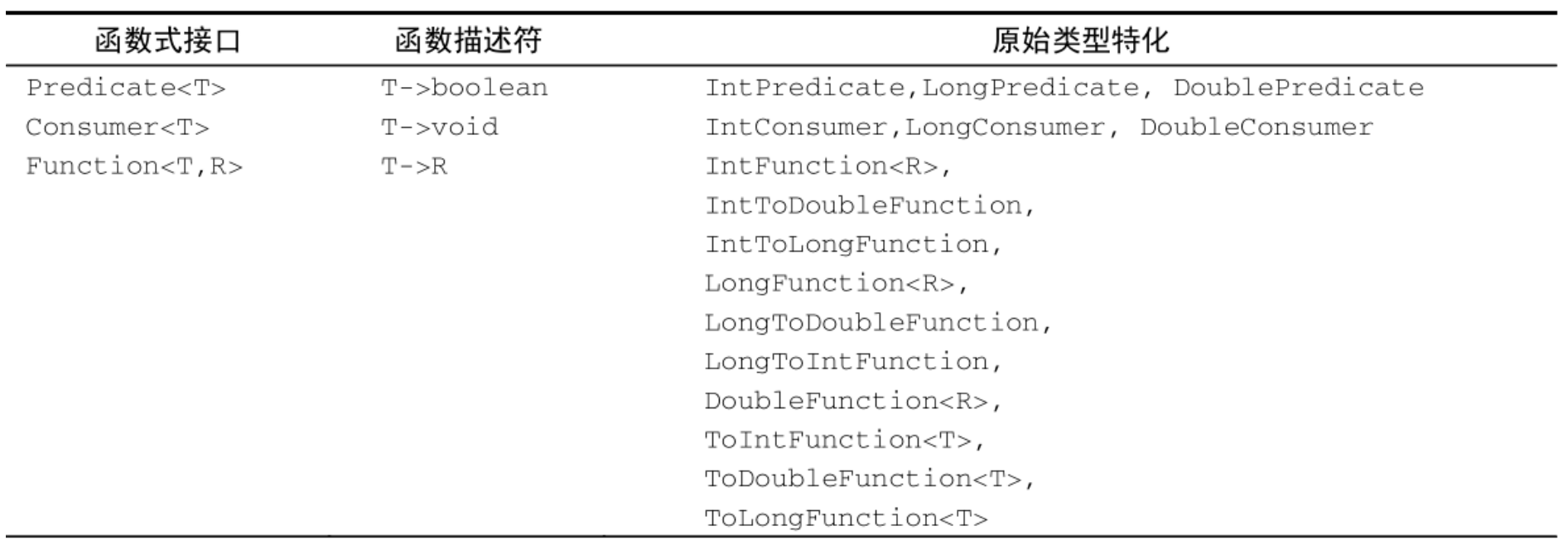
下面详细介绍一下这些接口,并简单使用一下
Predicate
test9包下的内容
首先看一下定义
@FunctionalInterface
public interface Predicate<T> {
/**
* Evaluates this predicate on the given argument.
*
* @param t the input argument
* @return {@code true} if the input argument matches the predicate,
* otherwise {@code false}
*/
boolean test(T t);
}
抽象方法为test,初次之外,还提供了一些其他实现,例如将两个断言以and或者or的方式连接,或者是对一个断言取反
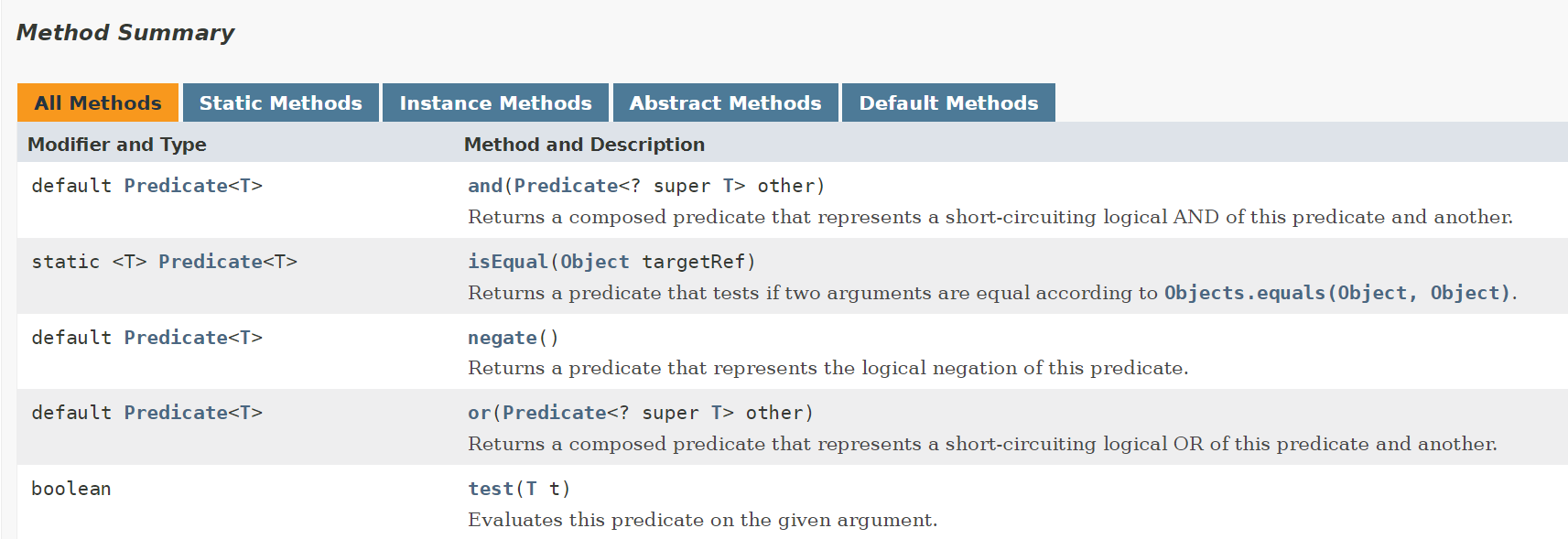
下面是一个示例
package com.lln.java8.functional.test9;
import java.util.ArrayList;
import java.util.Arrays;
import java.util.List;
import java.util.function.Predicate;
public class Main {
public static void main(String[] args) {
//测试list里面的每个数字是否都大于5
List<Integer> list = new ArrayList<>(Arrays.asList(1, 2, 3, 4, 5, 6, 7, 8));
Predicate<Integer> predicate = number -> number > 5;
//测试list里面每个数字是不是都大于5
System.out.println(test(list, predicate));
//测试list里面每个数字是不是都小于等于5
Predicate<Integer> negate = predicate.negate();
System.out.println(test(list, negate));
//测试list里面的每个数字是不是都既大于5 又小于等于5,明显不可能,只是个例子
Predicate<Integer> and = predicate.and(negate);
System.out.println(test(list, and));
//测试list里面的每个数字是不是都大于5或者小于等于5
Predicate<Integer> or = predicate.or(negate);
System.out.println(test(list, or));
//还有一个例子,在Collection集合中,有一个方法,default boolean removeIf(Predicate<? super E> filter)
//可以移除满足条件的值,例如,移除大于5的值
list.removeIf(predicate);
System.out.println(list);
}
private static <T> boolean test(List<T> list, Predicate<T> predicate) {
for (T t : list) {
if (!predicate.test(t)) {
return false;
}
}
return true;
}
}
removeIf的实现
Consumer
test10包下的内容
先看一下Consumer的定义
@FunctionalInterface
public interface Consumer<T> {
/**
* Performs this operation on the given argument.
*
* @param t the input argument
*/
void accept(T t);
}
抽象方法为accept,初次之外还有一个默认的方法,可以将两个Consumer进行连接,让他干完这件事接着去干下一件

下面是两个示例
package com.lln.java8.functional.test10;
import java.util.function.Consumer;
public class Main {
public static void main(String[] args) {
Test test = new Test("Hello");
//对str进行反转
Consumer<Test> consumer1 = t -> {
StringBuilder stringBuilder = new StringBuilder(test.str);
test.str = stringBuilder.reverse().toString();
};
//对str进行大写
Consumer<Test> consumer2 = t -> t.str = t.str.toUpperCase();
//对str先进行反转,然后再全大写
Consumer<Test> consumer3 = consumer1.andThen(consumer2);
consumer1.accept(test);
System.out.println(test.str);
test.str = "Hello";
consumer2.accept(test);
System.out.println(test.str);
test.str = "Hello";
consumer3.accept(test);
System.out.println(test.str);
}
private static class Test {
String str;
public Test(String str) {
this.str = str;
}
}
}
运行结果:
olleH HELLO OLLEH
package com.lln.java8.functional.test10;
import java.util.Arrays;
import java.util.List;
public class Main2 {
public static void main(String[] args) {
//在Java8中为Iterable接口中添加了一个默认方法,forEach,通过接受一个Consumer来及进行遍历
List<String> students = Arrays.asList("ZhangSan", "LiSi", "WangWu");
students.forEach(s -> System.out.println(s));
}
}
运行结果:
ZhangSan LiSi WangWu
forEach的实现
Function
test11包下的内容
先看一下定义
package java.util.function;
import java.util.Objects;
/**
* Represents a function that accepts one argument and produces a result.
*
* <p>This is a <a href="package-summary.html">functional interface</a>
* whose functional method is {@link #apply(Object)}.
*
* @param <T> the type of the input to the function
* @param <R> the type of the result of the function
*
* @since 1.8
*/
@FunctionalInterface
public interface Function<T, R> {
/**
* Applies this function to the given argument.
*
* @param t the function argument
* @return the function result
*/
R apply(T t);
/**
* Returns a composed function that first applies the {@code before}
* function to its input, and then applies this function to the result.
* If evaluation of either function throws an exception, it is relayed to
* the caller of the composed function.
*
* @param <V> the type of input to the {@code before} function, and to the
* composed function
* @param before the function to apply before this function is applied
* @return a composed function that first applies the {@code before}
* function and then applies this function
* @throws NullPointerException if before is null
*
* @see #andThen(Function)
*/
default <V> Function<V, R> compose(Function<? super V, ? extends T> before) {
Objects.requireNonNull(before);
return (V v) -> apply(before.apply(v));
}
/**
* Returns a composed function that first applies this function to
* its input, and then applies the {@code after} function to the result.
* If evaluation of either function throws an exception, it is relayed to
* the caller of the composed function.
*
* @param <V> the type of output of the {@code after} function, and of the
* composed function
* @param after the function to apply after this function is applied
* @return a composed function that first applies this function and then
* applies the {@code after} function
* @throws NullPointerException if after is null
*
* @see #compose(Function)
*/
default <V> Function<T, V> andThen(Function<? super R, ? extends V> after) {
Objects.requireNonNull(after);
return (T t) -> after.apply(apply(t));
}
/**
* Returns a function that always returns its input argument.
*
* @param <T> the type of the input and output objects to the function
* @return a function that always returns its input argument
*/
static <T> Function<T, T> identity() {
return t -> t;
}
}
抽象方法为apply 除此之外,还存在两个方法,用来连接两个函数

下面是一个示例
package com.lln.java8.functional.test11;
import java.util.Collections;
import java.util.HashSet;
import java.util.Set;
import java.util.function.Function;
public class Main {
public static void main(String[] args) {
String str = "a-b-c-d-e-f-g-a-b-c";
// 定义第一个方法,可以将字符串通过-分割,并返回一个数组
Function<String, String[]> function1 = s -> s.split("-");
// 定义第二个方法,可以将一个字符串数组转换为一个list
Function<String[], Set<String>> function2 = arr -> {
HashSet<String> set = new HashSet<>();
Collections.addAll(set, arr);
return set;
};
// 第三个方法是通过第一个和第二个组合而成的,使用了andThen方法
Function<String, Set<String>> function3 = function1.andThen(function2);
// compose类似
// 调用第三个方法
Set<String> result = function3.apply(str);
result.forEach(s -> System.out.println(s));
}
}
运行结果:
a b c d e f g
在jdk1.8中map中新增了方法computeIfAbsent,可以给定一个key和一个函数,如果key不存在,则使用函数生成一个value,并将key和value添加到map中,如下
package com.lln.java8.functional.test11;
import java.util.HashMap;
import java.util.Map;
public class Main2 {
public static void main(String[] args) {
Map<String, String> map = new HashMap<>();
map.put("1", "111");
map.put("2", "222");
map.computeIfAbsent("3", s -> s + s + s);
map.forEach((s, s2) -> {
System.out.println(s + "---" + s2);
});
}
}
运行结果
1—111 2—222 3—333
Supplier
test12包下的内容
先看其定义
package java.util.function;
/**
* Represents a supplier of results.
*
* <p>There is no requirement that a new or distinct result be returned each
* time the supplier is invoked.
*
* <p>This is a <a href="package-summary.html">functional interface</a>
* whose functional method is {@link #get()}.
*
* @param <T> the type of results supplied by this supplier
*
* @since 1.8
*/
@FunctionalInterface
public interface Supplier<T> {
/**
* Gets a result.
*
* @return a result
*/
T get();
}

抽象方法为get,它不存在任何的参数,直接用来生成一个内容
例如
package com.lln.java8.functional.test12;
import java.util.UUID;
import java.util.function.Supplier;
public class Main {
public static void main(String[] args) {
// 生产者,我们创建一个生产者,用于生成uuid
Supplier<String> uuidGenerator = () -> UUID.randomUUID().toString();
for (int i = 0; i < 5; i++) {
System.out.println(uuidGenerator.get());
}
}
}
运行结果
e8c9b5a3-867b-4917-8258-323647a0e808 3c9ed072-47c7-4ff9-b9e6-f3352930879b 0b73abe3-8e11-4a55-a795-2de352754713 49c3fdfa-87bf-4449-b824-0d576437e30f 6c154a39-0be4-4e68-b2fd-1d1f5c09ae7b
方法引用
上面我们介绍了lambda表达式,都是直接定义的,有没有什么方法可以让我们直接使用已有方法,一个函数接口的实现呢,这里实际上就类似c++里面的函数指针了,这里就引入了方法引用的特性。
因为lambda表达式实际上由三部分组成,参数,函数体,返回值,所以只要是这三者都相等的情况下,我们就可以认为两个是相等的。
例如test13包下的内容
package com.lln.java8.functional.test13;
public class Main {
public static void main(String[] args) {
// Runnable接口的函数,也是无参无返回值的函数,和Test的function方法的三要素是相同的
// 所以我们可以直接引用Test::function
Runnable runnable = Test::function;
runnable.run();
}
static class Test {
/**
* 无参无返回值的函数
*/
static void function() {
System.out.println("Test#function");
}
}
}
运行结果
Test#function
静态方法引用
直接使用类名::方法名即可进行引用
如下面的两个例子
package com.lln.java8.functional.test13;
import com.lln.java8.functional.test4.Action;
import java.util.Collections;
import java.util.Map;
import java.util.Set;
import java.util.function.Consumer;
import java.util.function.Supplier;
public class Main2 {
public static void main(String[] args) {
// 例如我们可以直接引用Collections的emptySet方法,返回一个空的set
Supplier<Set<String>> emptyMap = Collections::emptySet;
Set<String> emptySet = emptyMap.get();
// 或者还可以直接引用这个类的main方法
Consumer<String[]> main = Main2::main;
// 不能调用,会溢出
// main.accept(new String[]{});
}
}
非静态方法引用
基于类名引用
因为需要对象才能调用,所以这里接口的第一个参数必须是类的实例对象,后面才是若干参数
如test14包下的内容
package com.lln.java8.functional.test14;
import java.util.function.Function;
public class Main {
public static void main(String[] args) {
Function<Test, String> function = Test::function;
FunctionInterface1 function1 = Test::function1;
FunctionInterface2 function2 = Test::function2;
Test test = new Test(6);
System.out.println(function.apply(test));
Test test1 = new Test(8);
System.out.println(function1.run(test1, "test1"));
Test test2 = new Test(10);
System.out.println(function2.run(test2, "test2-1", "test2-2"));
}
@FunctionalInterface
public interface FunctionInterface1 {
String run(Test test, String arg);
}
@FunctionalInterface
public interface FunctionInterface2 {
String run(Test test, String arg1, String arg2);
}
public static class Test {
private final int mMyNumber;
public Test(int myNumber) {
this.mMyNumber = myNumber;
}
public String function() {
return String.valueOf(mMyNumber);
}
public String function1(String arg) {
return mMyNumber + "--" + arg;
}
public String function2(String arg1, String arg2) {
return mMyNumber + "--" + arg1 + "--" + arg2;
}
}
}
运行结果
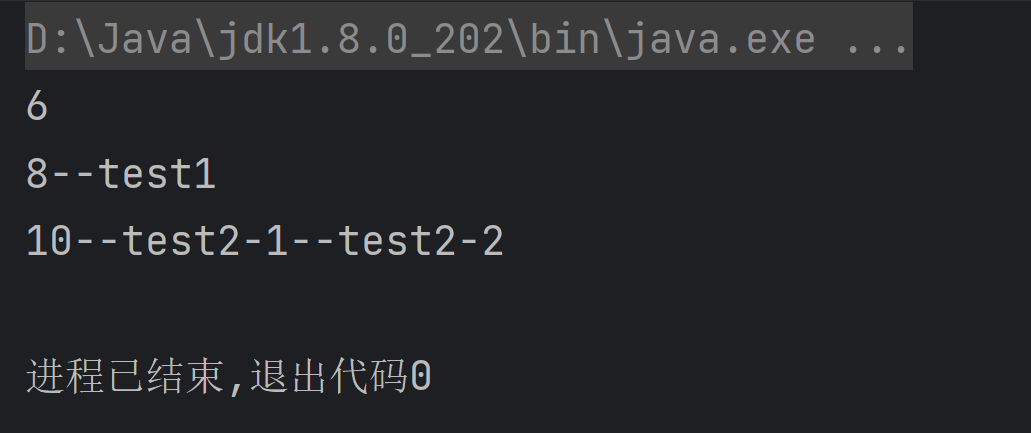
基于对象引用
如果已经是基于对象来引用的,也就不需要再传入相应的对象了,调用方法的时候,就是基于这个对象来调用。
如test15包下的内容
package com.lln.java8.functional.test15;
import java.util.function.Supplier;
public class Main {
public static void main(String[] args) {
Test test = new Test(6);
// 这里supplier就可接收了
Supplier<String> function = test::function;
System.out.println(function.get());
Test test1 = new Test(8);
FunctionInterface1 function1 = test1::function1;
System.out.println(function1.run("test1"));
Test test2 = new Test(10);
FunctionInterface2 function2 = test2::function2;
System.out.println(function2.run("test2-1", "test2-2"));
}
@FunctionalInterface
public interface FunctionInterface1 {
String run(String arg);
}
@FunctionalInterface
public interface FunctionInterface2 {
String run(String arg1, String arg2);
}
public static class Test {
private final int mMyNumber;
public Test(int myNumber) {
this.mMyNumber = myNumber;
}
public String function() {
return String.valueOf(mMyNumber);
}
public String function1(String arg) {
return mMyNumber + "--" + arg;
}
public String function2(String arg1, String arg2) {
return mMyNumber + "--" + arg1 + "--" + arg2;
}
}
}
运行结果
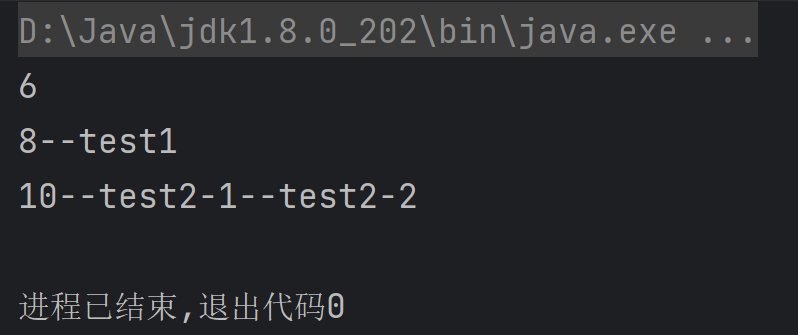
构造方法引用
针对普通对象构造方法的引用,我们直接写类名::new即可,实际引用到哪个构造方法,编译器会根据提供的函数式接口来自动推断。
针对数组构造方法的引用,我们和普通对象一致,例如int[]::new,数组的构造方法的形参为需要的数组长度。
如test16包下的内容
package com.lln.java8.functional.test16;
import java.util.function.*;
public class Main {
public static void main(String[] args) {
// 会引用无参数的构造方法
Supplier<Test> constructor = Test::new;
Test test = constructor.get();
System.out.println(test.getMyNumber());
// 引用一个参数的构造方法
Function<Integer, Test> constructor1 = Test::new;
Test test1 = constructor1.apply(5);
System.out.println(test1.getMyNumber());
// 引用两个参数的构造方法
BiFunction<Integer, Integer, Test> constructor2 = Test::new;
Test test2 = constructor2.apply(5, 8);
System.out.println(test2.getMyNumber());
// 引用数组的构造方法
FunctionInterface arrayConstructor = int[]::new;
int[] array = arrayConstructor.run(5);
System.out.println(array.length);
}
private interface FunctionInterface {
int[] run(int length);
}
private static class Test {
private final int mMyNumber;
public Test() {
this.mMyNumber = 0;
}
public Test(int number) {
this.mMyNumber = number;
}
public Test(int number1, int number2) {
this.mMyNumber = number1 + number2;
}
public int getMyNumber() {
return mMyNumber;
}
}
}
运行结果
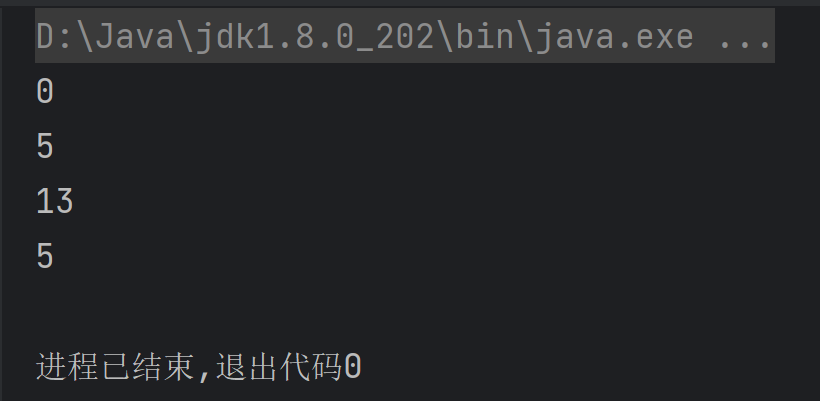
Optional
这里指的是java.util.Optional这个类,它主要是为了解决java中的空指针问题,通过使用此类对对象做包装,它包装的内容可以是null,也可以不是null,我们建议对内容的返回不要使用null,而是使用Optional,这样规避空指针问题。
同时,其提供了一系列方法让我们去操作optional直接看代码,例如test17包下的内容,(这里只进行一些简单的使用,详细内容可看官方API)
https://docs.oracle.com/javase/8/docs/api/java/util/Optional.html
package com.lln.java8.functional.test17;
import java.util.Optional;
public class Main {
public static void main(String[] args) {
// 创建一个optional
Optional<Test> optional = Optional.of(new Test((int) (Math.random() * 10 + 1)));
// 创建一个optional 可能为null
Optional<Test> optionalMayNull = Optional.ofNullable(Math.random() > 0.5 ? null : new Test(5));
// 创建一个空的optional
Optional<Test> optionalEmpty = Optional.empty();
// isPresent 判断optional是否有值
System.out.println("----isPresent--start--");
System.out.println(optional.isPresent());
System.out.println(optionalMayNull.isPresent());
System.out.println(optionalEmpty.isPresent());
System.out.println("----isPresent--end--\n\n");
// ifPresent 如果存在值,我们执行给定的函数,否则不执行
System.out.println("----ifPresent--start--");
optional.ifPresent(test -> System.out.println(test.getMyNumber()));
System.out.println("----ifPresent--end--\n\n");
// filter 过滤(其实这个操作更应该应用于流),给定一个条件,在存在的条件下我们进行判断,返回判断结果
System.out.println("----filter--start--");
optional.filter(test -> test.mMyNumber > 5)
.ifPresent(test -> System.out.println(test.getMyNumber()));
System.out.println("----filter--end--\n\n");
// orElse 不存在返回另一个值
System.out.println("----orElse--start--");
Test test = optionalMayNull.orElse(new Test(7));
System.out.println(test.getMyNumber());
System.out.println("----orElse--end--\n\n");
// orElseGet 不存在就调用来生成一个
System.out.println("----orElseGet--start--");
Test test1 = optionalMayNull.orElseGet(Test::new);
System.out.println(test1.getMyNumber());
System.out.println("----orElseGet--end--\n\n");
// map 映射,若这个optional存在值,则进行映射成另一个对象
System.out.println("----map--start--");
Optional<Integer> number = optional.map(Test::getMyNumber);
number.ifPresent(System.out::println);
System.out.println("----map--end--\n\n");
// flatMap 映射 和map类似,只不过它的返回值必须是一个optional 且返回值不会再被optional包装
System.out.println("----flatMap--start--");
Optional<Integer> number1 = optional.flatMap(test2 -> Optional.of(88));
number1.ifPresent(System.out::println);
System.out.println("----flatMap--end--\n\n");
}
private static class Test {
private final int mMyNumber;
public Test(int number) {
this.mMyNumber = number;
}
public Test() {
this.mMyNumber = 666;
}
public int getMyNumber() {
return mMyNumber;
}
}
}
运行结果,因为存在随机数,所以每次运行结果不会一样
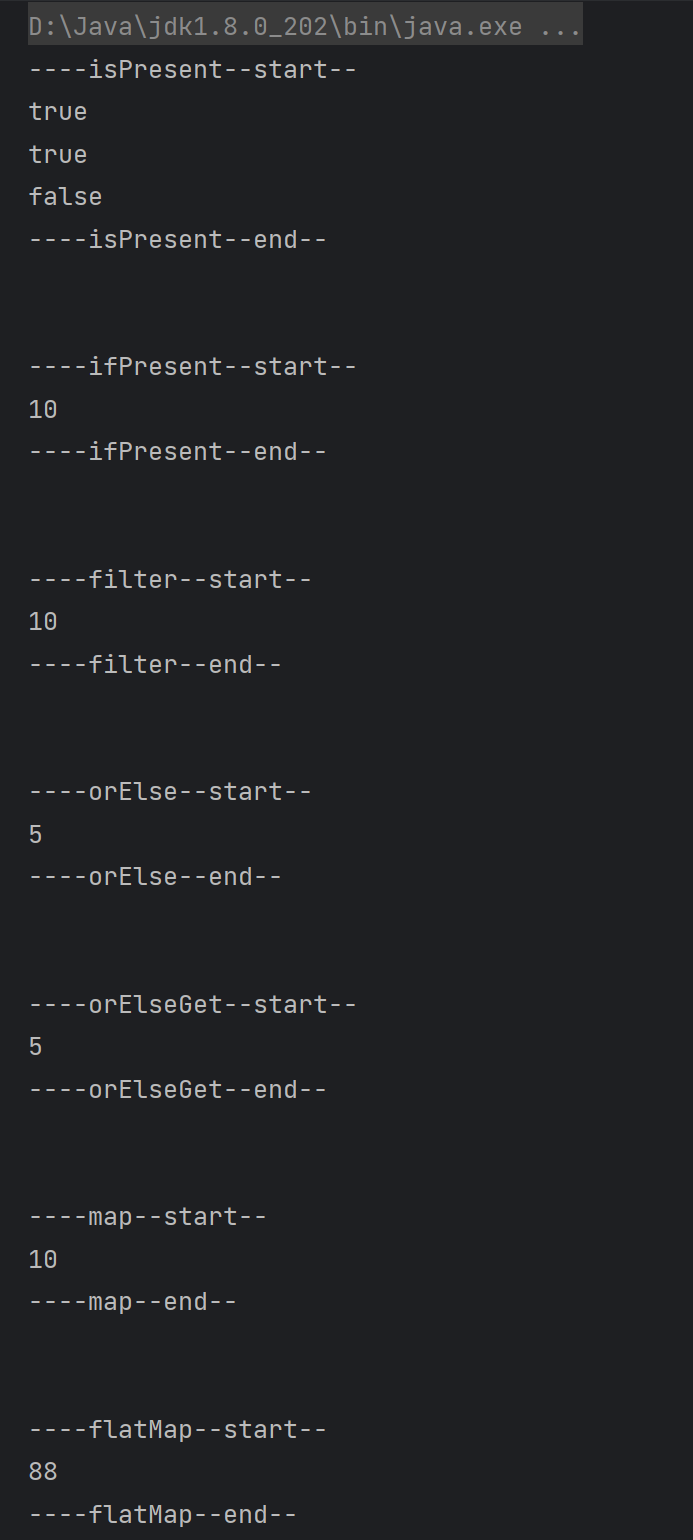
Stream
这里的stream指的是java.util.stream接口,它支持对集合java.util.Collection进行操作,Stream是对集合功能的增强,提供了很多便利、高效的聚合操作,结合lambda表达式,可以大大提高效率。
下面是一个例子
package com.lln.java8.functional.test18;
import java.awt.Color;
import java.util.List;
import java.util.stream.Collectors;
import java.util.stream.IntStream;
public class Main {
public static void main(String[] args) {
// 现在我们有100个组件 每个组件由颜色和权重组成,我们需要求红色的权重
List<Widget> widgets = IntStream.range(0, 100)
.mapToObj(value -> new Widget(getRandomColor(), (int) (Math.random() * 100)))
.collect(Collectors.toList());
// 如果使用传统方案,应该是这样
int redWeight = 0;
for (Widget widget : widgets) {
if (widget.getColor() == Color.RED) {
redWeight += widget.getWeight();
}
}
System.out.println("红色的权重为: " + redWeight);
// 如果使用流,它可以这样写
System.out.println("红色的权重为: " +
widgets.stream()
.filter(widget -> widget.getColor() == Color.RED)
.mapToInt(Widget::getWeight)
.sum());
}
private static Color getRandomColor() {
switch ((int) (Math.random() * 5)) {
case 0:
return Color.RED;
case 1:
return Color.BLACK;
case 2:
return Color.YELLOW;
case 3:
return Color.ORANGE;
case 4:
return Color.BLUE;
default:
return Color.WHITE;
}
}
private static class Widget {
private Color mColor;
private int mWeight;
public Widget(Color color, int weight) {
this.mColor = color;
this.mWeight = weight;
}
public Color getColor() {
return mColor;
}
public void setColor(Color color) {
mColor = color;
}
public int getWeight() {
return mWeight;
}
public void setWeight(int weight) {
mWeight = weight;
}
}
}
通过上面的例子,可以看到,使用流来处理数据能让我们的代码看起来更简单易懂
流的操作主要有两种,中间操作和最终操作
-
中间操作操作结果返回流的本身
例如:map、flatMap、filter、distinct、sorted、peek、limit、skip、parallel、sequential、unordered
-
最终操作返回特定的计算结果
例如:forEach、forEachOrdered、toArray、reduce、collect、min、max、count、anyMatch、allMatch、noneMatch、findFirst、findAny、iterator
详细的介绍可以参考API
https://docs.oracle.com/javase/8/docs/api/java/util/stream/Stream.html
如何生成stream
直接生成
使用Stream#of方法
例如Stream.of("a","b")
数组转stream
使用Arrays#stream方法
例如Arrays.stream(arr)
集合转stream
使用Collection#stream方法
例如new ArrayList<String>().stream()
基本数据类型
对于基本数据类型,这里引入了
IntStream
LongStream
DoubleStream
虽然可以使用泛型来实现,但是数据量比较大的时候,频繁拆装箱,会耗费性能,所以引入了这些类型
示例如下
package com.lln.java8.functional.test18;
import java.util.ArrayList;
import java.util.Arrays;
import java.util.Collections;
import java.util.List;
import java.util.stream.IntStream;
import java.util.stream.Stream;
public class Main2 {
public static void main(String[] args) {
// 直接使用Stream#of方法
System.out.println("stream of");
Stream<String> stringStream = Stream.of("a", "b", "c", "d");
stringStream.forEach(System.out::println);
System.out.println("\n");
// 数组转stream,使用Arrays.stream方法
System.out.println("Arrays.stream");
String[] arr = {"a", "b", "c", "d"};
Stream<String> stream = Arrays.stream(arr);
stream.forEach(System.out::println);
System.out.println("\n");
// 集合转stream 使用Collection#stream方法
System.out.println("Collection#stream");
List<String> strings = new ArrayList<>();
Collections.addAll(strings, "a", "b", "c", "d");
Stream<String> stringStream1 = strings.stream();
stringStream1.forEach(System.out::println);
System.out.println("\n");
// 0,1,2
System.out.println("range");
IntStream intStream = IntStream.range(0, 3);
intStream.forEach(System.out::println);
System.out.println("\n");
// 0,1,2,3
System.out.println("rangeClosed");
IntStream intStream1 = IntStream.rangeClosed(0, 3);
intStream1.forEach(System.out::println);
System.out.println("\n");
System.out.println("of");
IntStream intStream2 = IntStream.of(1, 2, 3, 4, 5);
intStream2.forEach(System.out::println);
System.out.println("\n");
}
}
运行结果
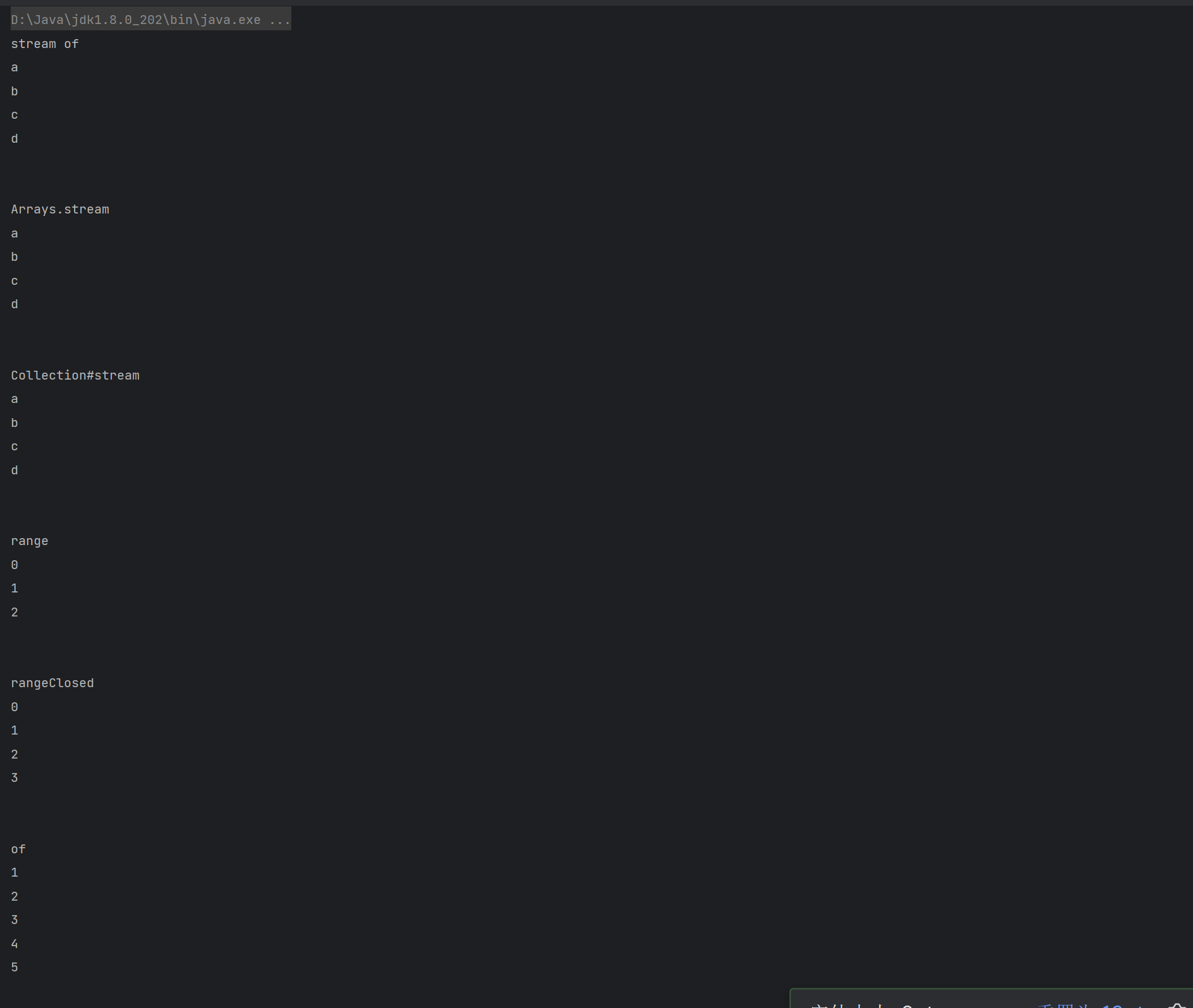
如何将反向转换
转数组
将流转换为数组,可以使用Stream#toArray方法
转集合
将流转换为集合,可以使用Stream#collect方法
collect这个方法为收集,实际上,通过此接口还可以将其进行连接、分组等操作
示例如下
package com.lln.java8.functional.test18;
import java.util.ArrayList;
import java.util.Arrays;
import java.util.Collections;
import java.util.HashSet;
import java.util.List;
import java.util.Set;
import java.util.stream.Collectors;
import java.util.stream.IntStream;
import java.util.stream.Stream;
public class Main3 {
public static void main(String[] args) {
Stream<String> stringStream = Stream.of("a", "b", "c", "d");
// 转数组
System.out.println("toArray");
String[] array = stringStream.toArray(String[]::new);
System.out.println(Arrays.toString(array) + "\n");
// 转集合 set
System.out.println("toSet");
stringStream = Stream.of("a", "b", "c", "d");
Set<String> stringSet = stringStream.collect(Collectors.toSet());
stringSet.forEach(System.out::println);
System.out.println();
// 或
//Set<String> stringHashSet = stringStream.collect(Collectors.toCollection(HashSet::new));
// 转list
System.out.println("toList");
stringStream = Stream.of("a", "b", "c", "d");
List<String> stringList = stringStream.collect(Collectors.toList());
stringList.forEach(System.out::println);
System.out.println();
// 或
// ArrayList<String> stringArrayList = stringStream.collect(Collectors.toCollection(ArrayList::new));
// 可以将流里面的东西连接起来转成string
stringStream = Stream.of("a", "b", "c", "d");
System.out.println(stringStream.collect(Collectors.joining()));
stringStream = Stream.of("a", "b", "c", "d");
System.out.println(stringStream.collect(Collectors.joining("-")));
stringStream = Stream.of("a", "b", "c", "d");
System.out.println(stringStream.collect(Collectors.joining("-", "start:", ":end")));
}
}
运行结果
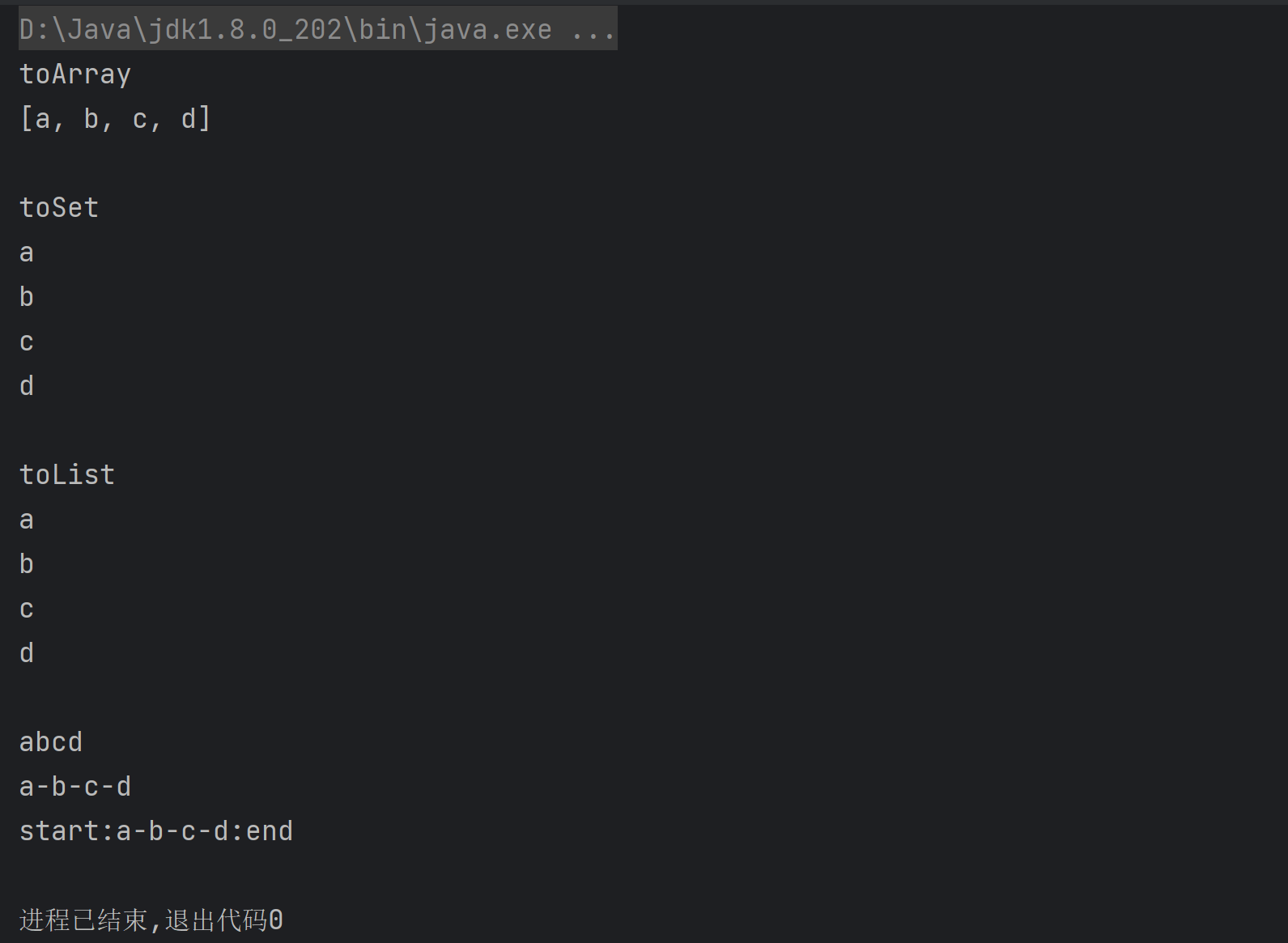
Stream操作
最终操作
下方示例见test19包下的内容
iterator
该方法可以返回迭代器对象
例如
package com.lln.java8.functional.test19;
import java.util.Iterator;
import java.util.stream.Stream;
public class Main {
public static void main(String[] args) {
Stream<String> stringStream = Stream.of("a", "b", "c", "d");
Iterator<String> iterator = stringStream.iterator();
while (iterator.hasNext()) {
System.out.println(iterator.next());
}
}
}

foreach
常用的遍历
例如
package com.lln.java8.functional.test19;
import java.util.stream.Stream;
public class Main2 {
public static void main(String[] args) {
Stream<String> stringStream = Stream.of("a", "b", "c", "d");
stringStream.forEach(System.out::println);
}
}
运行结果
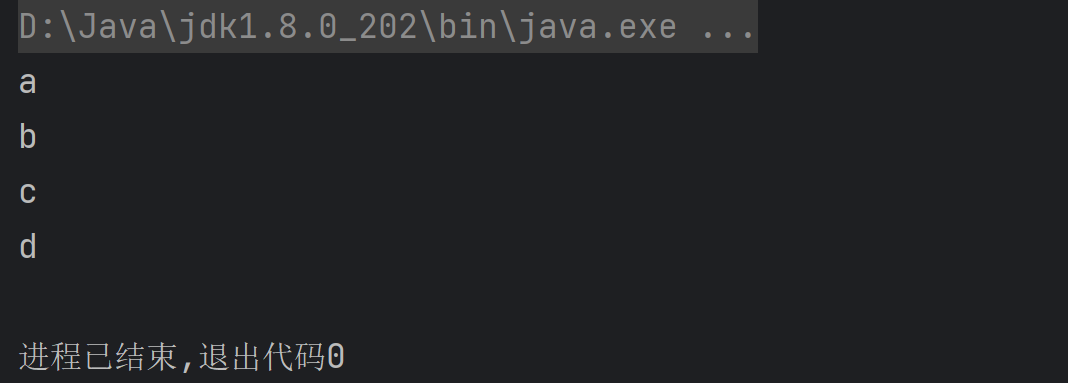
count
用于统计流里面元素的数量
package com.lln.java8.functional.test19;
import java.util.stream.Stream;
public class Main3 {
public static void main(String[] args) {
Stream<String> stringStream = Stream.of("a", "b", "c", "d");
System.out.println(stringStream.count());
}
}
运行结果

max
求最大值
package com.lln.java8.functional.test19;
import java.util.stream.Stream;
public class Main4 {
public static void main(String[] args) {
Stream<String> stringStream = Stream.of("a", "b", "c", "d");
stringStream.max(String::compareTo).ifPresent(System.out::println);
}
}
运行结果

min
求最小值
package com.lln.java8.functional.test19;
import java.util.stream.Stream;
public class Main5 {
public static void main(String[] args) {
Stream<String> stringStream = Stream.of("a", "b", "c", "d");
stringStream.min(String::compareTo).ifPresent(System.out::println);
}
}
运行结果

toArray
这个上面已经描述过了,可以将流转换为一个数组
collect
上面我们说过,该接口可以将流转换为集合,或者可以连接所有元素,除此之外,它还可以进行分组或者可以通过自定义收集器来实现其他的操作。
例如
package com.lln.java8.functional.test19;
import java.util.List;
import java.util.Map;
import java.util.stream.Collectors;
import java.util.stream.Stream;
public class Main6 {
public static void main(String[] args) {
System.out.println("groupByLength");
Stream<String> stringStream = Stream.of("aaaa", "bbbb", "ccccc", "ddd");
// 按照长度分组
Map<Integer, List<String>> groupByLength = stringStream.collect(Collectors.groupingBy(String::length));
groupByLength.forEach((key, result) -> System.out.println(key + "--" + String.join(",", result)));
System.out.println();
System.out.println("partitionByLength");
stringStream = Stream.of("aaaa", "bbbb", "ccccc", "ddd");
// 按照长度分区
Map<Boolean, List<String>> partitionByLength = stringStream.collect(Collectors.partitioningBy(s -> s.length() == 4));
partitionByLength.forEach((key, result) -> System.out.println(key + "--" + String.join(",", result)));
}
}
运行结果
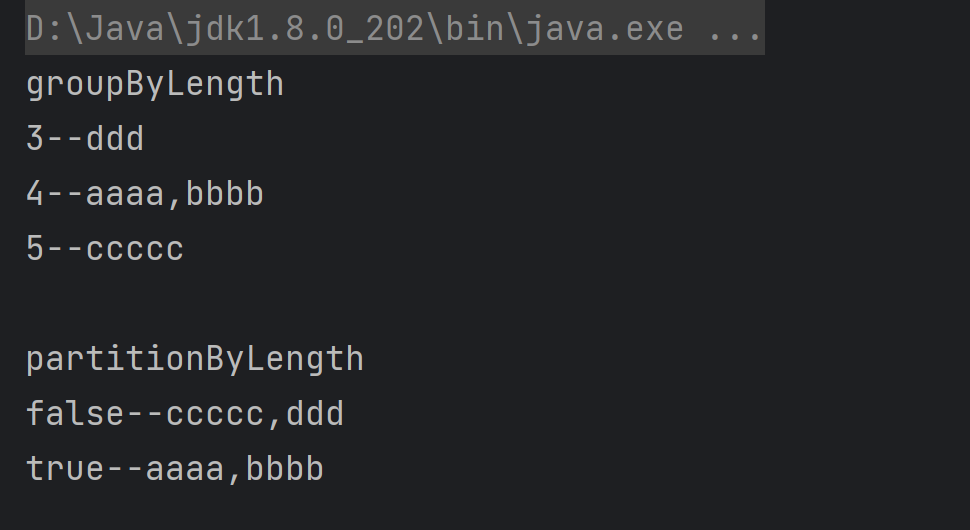
match
可以进行匹配操作,有任何一个满足、全部满足、都不满足
package com.lln.java8.functional.test19;
import java.util.Objects;
import java.util.stream.Stream;
public class Main7 {
public static void main(String[] args) {
Stream<String> stringStream = Stream.of("aaaa", "bbbb", "ccccc", "ddd");
// 有任何一个满足
System.out.println(stringStream.anyMatch(s -> s.length() == 5));
stringStream = Stream.of("aaaa", "bbbb", "ccccc", "ddd");
// 全部满足
System.out.println(stringStream.allMatch(Objects::nonNull));
stringStream = Stream.of("aaaa", "bbbb", "ccccc", "ddd");
// 都不满足
System.out.println(stringStream.noneMatch(s -> s.length() == 0));
}
}
运行结果
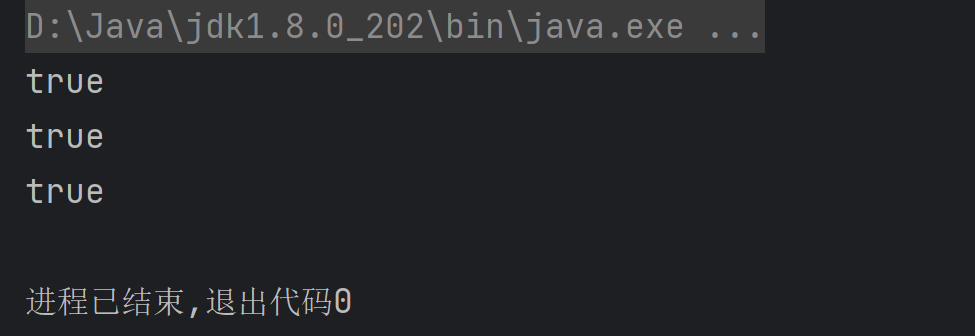
findFirst
获取第一个元素
package com.lln.java8.functional.test19;
import java.util.Comparator;
import java.util.stream.Stream;
public class Main8 {
public static void main(String[] args) {
Stream<String> stringStream = Stream.of("aaaa", "bbbb", "ccccc", "ddd");
stringStream.sorted(Comparator.comparingInt(String::length))
.findFirst()
.ifPresent(System.out::println);
}
}
运行结果

中间操作
filter
过滤,只保留流中的部分元素
package com.lln.java8.functional.test20;
import java.util.stream.Stream;
public class Main {
public static void main(String[] args) {
Stream<String> stringStream = Stream.of("aaaa", "bbbb", "ccccc", "ddd");
stringStream.filter(s -> s.length() == 5)
.forEach(System.out::println);
}
}
运行结果

map
映射,可以将一种类型映射到另一种类型上
package com.lln.java8.functional.test20;
import java.util.stream.Stream;
public class Main2 {
public static void main(String[] args) {
Stream<String> stringStream = Stream.of("aaaa", "bbbb", "ccccc", "ddd");
// 将流中的元素映射到新的类型上
Stream<Integer> integerStream = stringStream.map(String::length);
integerStream.forEach(System.out::println);
}
}
运行结果
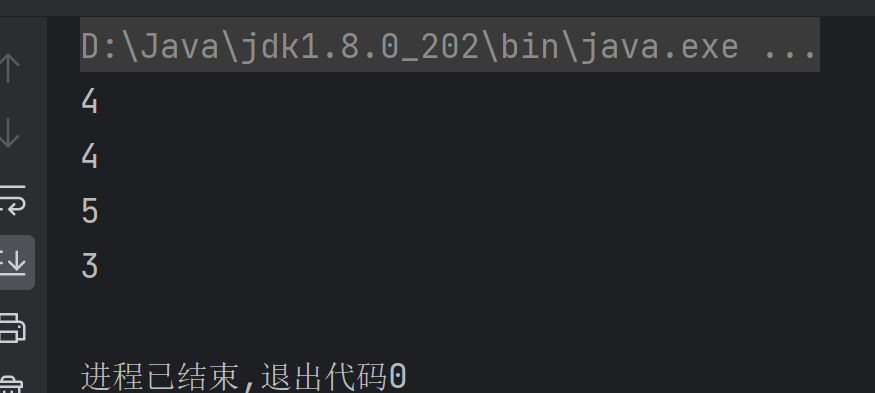
flatMap
和map类似,map是一对一映射,flatMap是一对多映射,可以将一个变成n个
例如
package com.lln.java8.functional.test20;
import java.util.Arrays;
import java.util.stream.Stream;
public class Main3 {
public static void main(String[] args) {
Stream<String> stringStream = Stream.of("aaaa", "bbbb", "ccccc", "ddd");
stringStream.flatMap(s -> Arrays.stream(s.split("")))
.forEach(System.out::println);
}
}
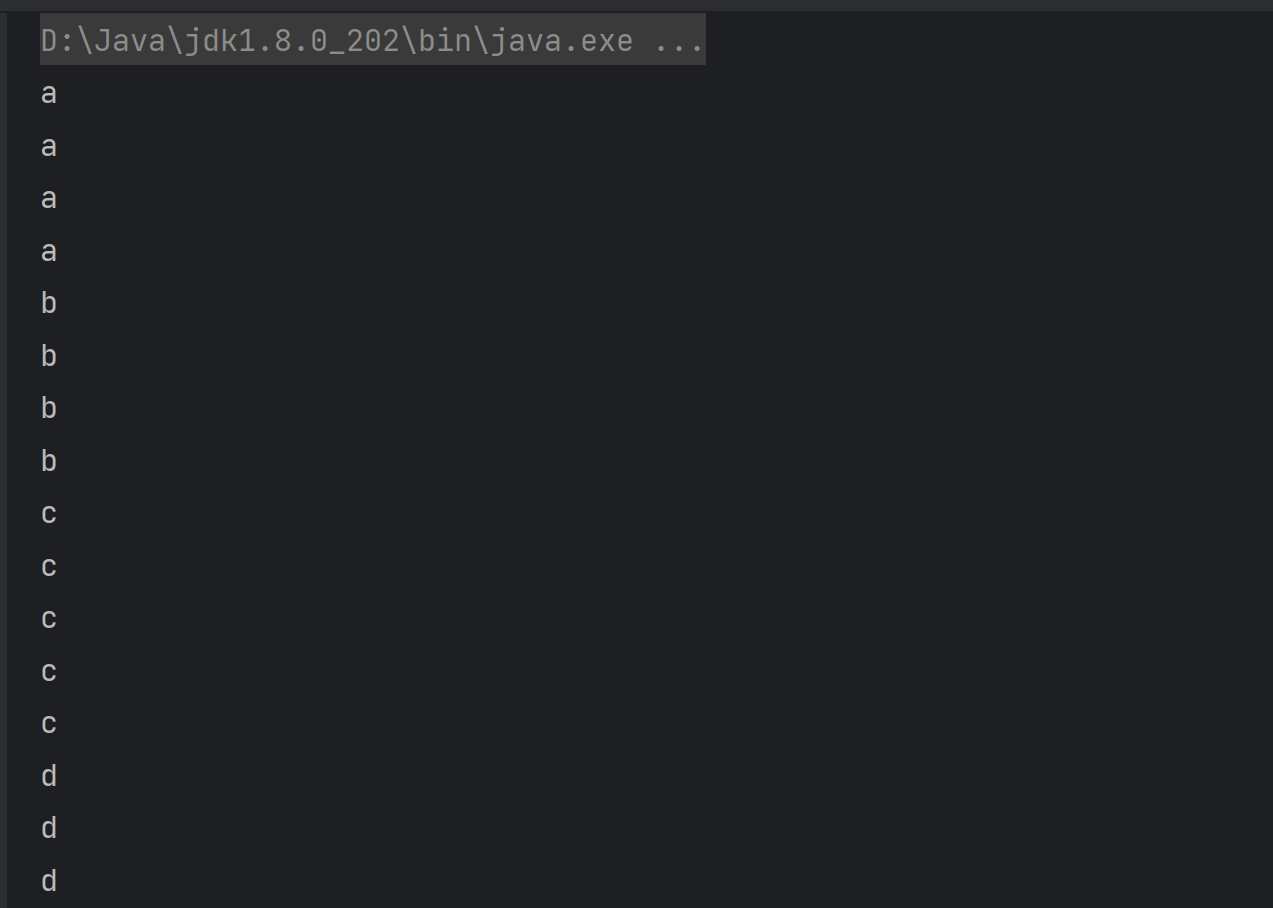
reduce
这里的操作属于将多个值进行相加
例如
package com.lln.java8.functional.test20;
import java.util.stream.Stream;
public class Main4 {
public static void main(String[] args) {
Stream<String> stringStream = Stream.of("aaaa", "bbbb", "ccccc", "ddd");
// 不传入起始值
stringStream.reduce((s, s2) -> s + s2).ifPresent(System.out::println);
stringStream = Stream.of("aaaa", "bbbb", "ccccc", "ddd");
// 传入起始值
System.out.println(stringStream.reduce("-----", (s, s2) -> s + s2));
}
}
运行结果

sorted
package com.lln.java8.functional.test20;
import java.util.stream.Stream;
public class Main5 {
public static void main(String[] args) {
Stream<String> stringStream = Stream.of("ccccc", "bbbb", "aaaa", "ddd");
// 使用不传入比较器,对象需要实现Comparable接口,否则会报错
stringStream.sorted().forEach(System.out::println);
System.out.println();
stringStream = Stream.of("ccccc", "bbbb", "aaaa", "ddd");
// 传入比较器的自定义实现 将排序反转
stringStream.sorted((o1, o2) -> -o1.compareTo(o2)).forEach(System.out::println);
}
}
运行结果
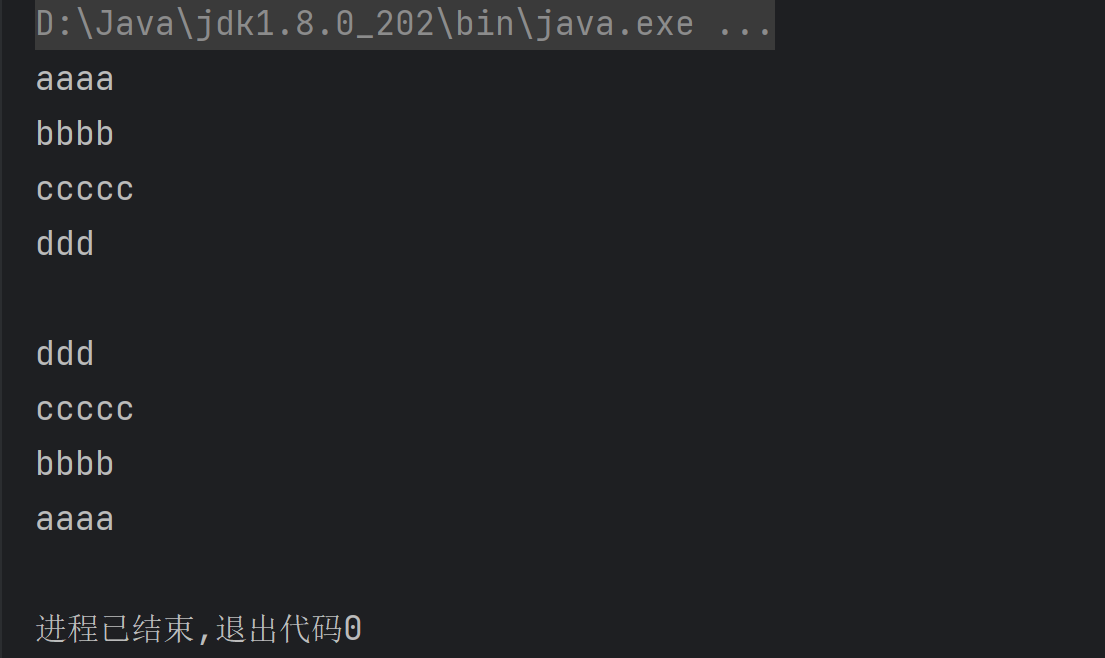
limit
只要n个元素
skip
跳过n个元素
package com.lln.java8.functional.test20;
import java.util.stream.Stream;
public class Main6 {
public static void main(String[] args) {
Stream<String> stringStream = Stream.of("aaaa", "bbbb", "ccccc", "ddd");
// 只要前面n个元素
stringStream.limit(3).forEach(System.out::println);
System.out.println();
stringStream = Stream.of("aaaa", "bbbb", "ccccc", "ddd");
// 跳过前面n个元素
stringStream.skip(3).forEach(System.out::println);
}
}
运行结果
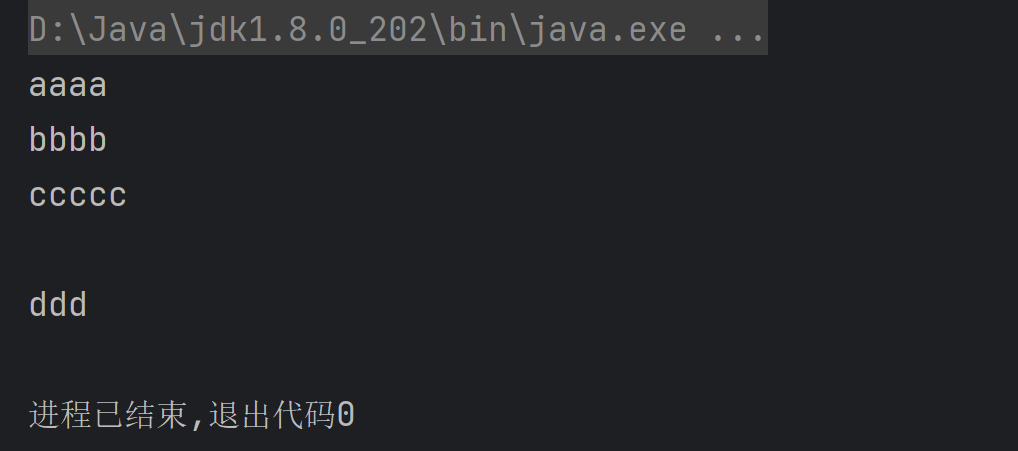
distinct
可去除流内所有重复的元素
package com.lln.java8.functional.test20;
import java.util.stream.Stream;
public class Main7 {
public static void main(String[] args) {
Stream<String> stringStream = Stream.of("aaaa", "bbbb", "aaaa", "ddd");
stringStream.distinct().forEach(System.out::println);
}
}
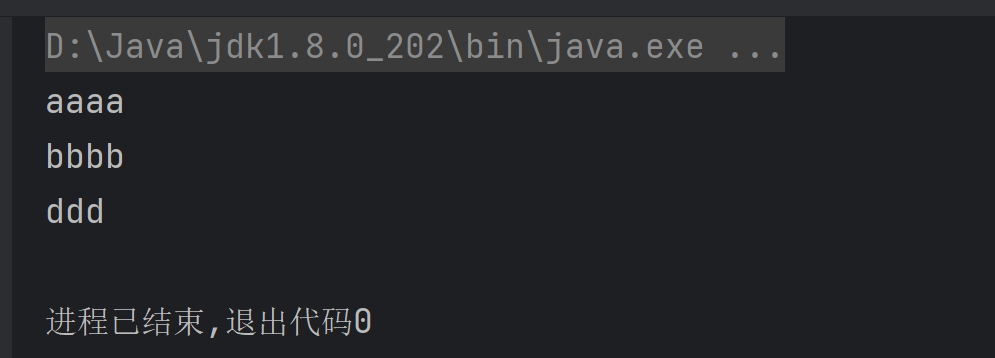
静态方法
concat
拼接两个流
package com.lln.java8.functional.test21;
import java.util.stream.Stream;
public class Main {
public static void main(String[] args) {
Stream<String> stringStream1 = Stream.of("aaaa", "bbbb", "ccccc", "ddd");
Stream<String> stringStream2 = Stream.of("aaaa", "bbbb", "ccccc", "ddd");
// 拼接两个流
Stream<String> stream = Stream.concat(stringStream1, stringStream2);
stream.forEach(System.out::println);
}
}
运行结果
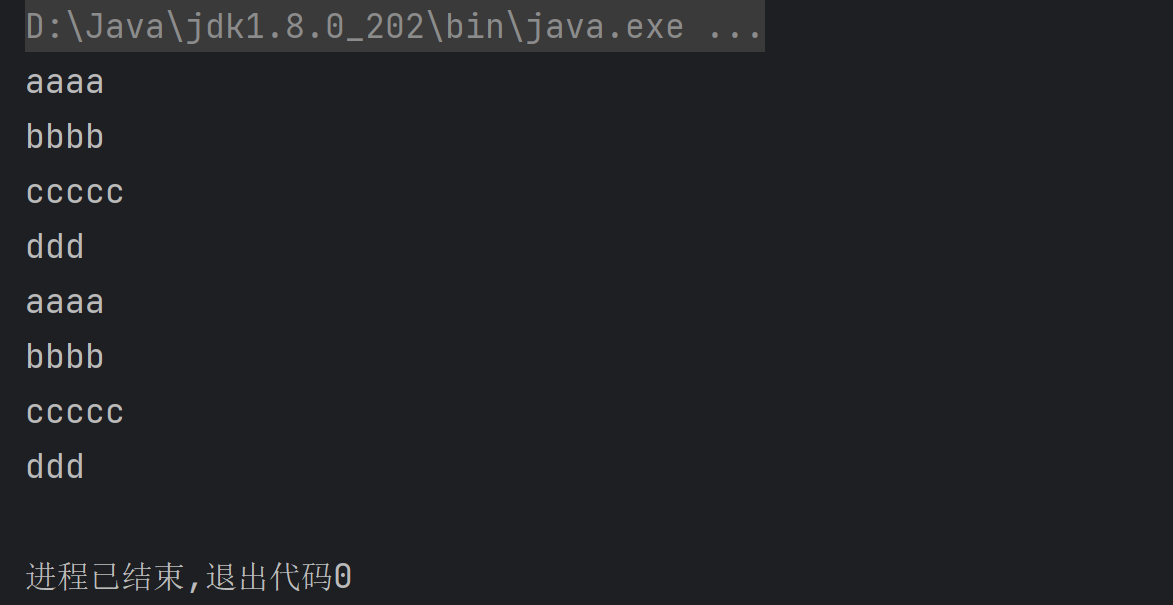
generate
生成,通过传入一个Supplier,可以生成一些内容
示例
package com.lln.java8.functional.test21;
import java.util.stream.Stream;
public class Main2 {
public static void main(String[] args) {
// 生成100个随机数
Stream.generate(Math::random)
.limit(100)
.forEach(System.out::println);
}
}

iterate
迭代操作,一个起始值,一直调用此方法并获得下一个值
package com.lln.java8.functional.test21;
import java.util.stream.Stream;
public class Main3 {
public static void main(String[] args) {
// 从1开始,每次+3,并输出
Stream.iterate(1, i -> i + 3)
.limit(10)
.forEach(System.out::println);
}
}
运行结果

IO流转Stream
在BufferedReader内新增方法lines,可以将文件内容转为流的形式
package com.lln.java8.functional.test22;
import java.io.BufferedReader;
import java.io.File;
import java.io.FileNotFoundException;
import java.io.FileReader;
public class Main {
public static void main(String[] args) throws FileNotFoundException {
File file = new File("assets/a.txt");
new BufferedReader(new FileReader(file))
.lines()
.forEach(System.out::println);
}
}
运行结果
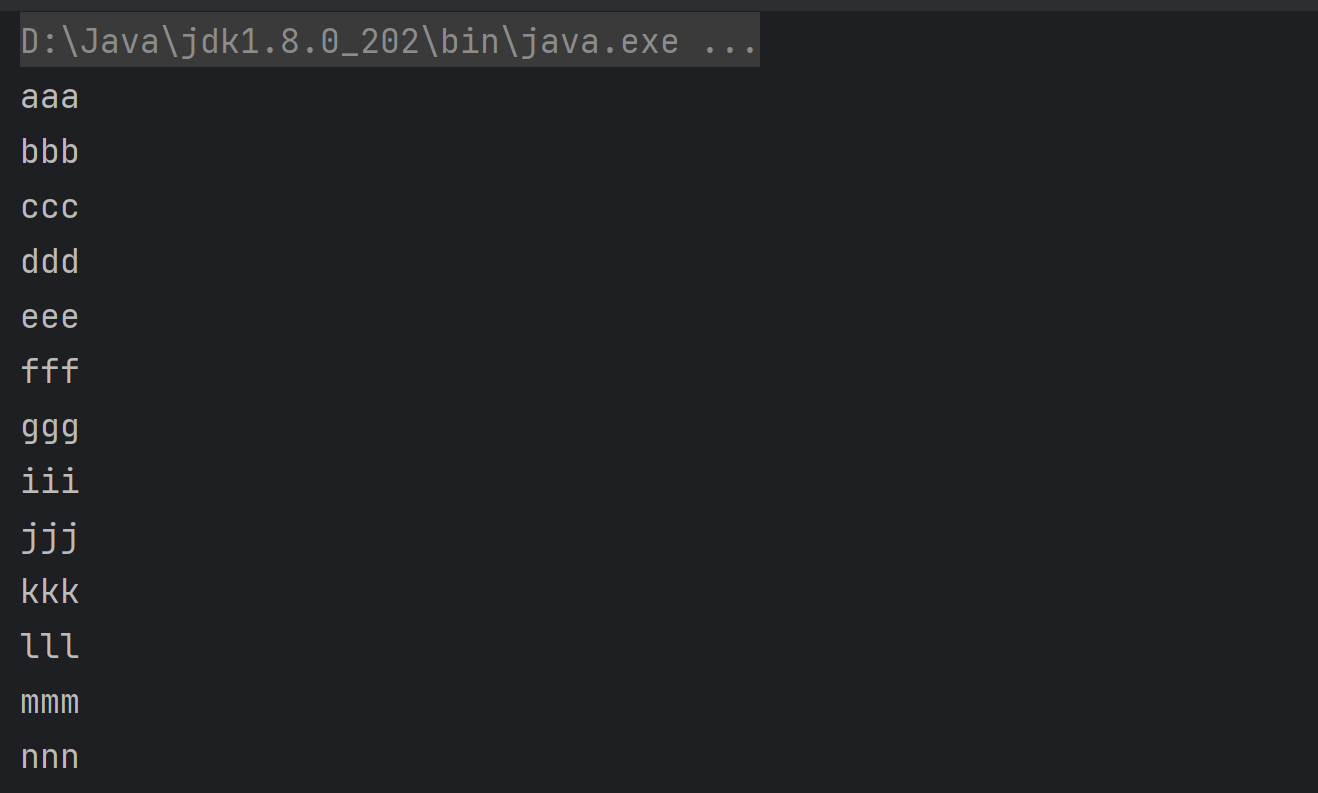
并行流
通过在Stream上调用parallel方法,可以获得一个并行的流,此流的执行速度比串行的速度要快
例如
package com.lln.java8.functional.test23;
import java.util.stream.Stream;
public class Main {
public static void main(String[] args) {
for (int i = 0; i < 10; i++) {
long l = System.currentTimeMillis();
Stream.generate(Math::random)
.parallel()
.limit(10000000)
.sorted()
.reduce(Double::sum)
.ifPresent(System.out::println);
System.out.println(System.currentTimeMillis() - l);
}
}
}
